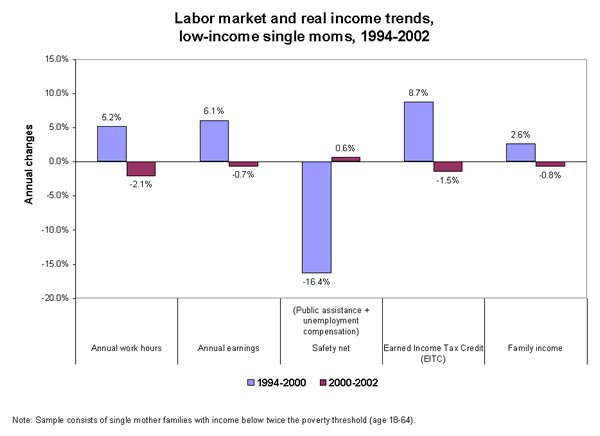See Snapshots Archive.
Snapshot for May 19, 2004.
Single moms lose ground in weak labor market
It has been widely documented that low-income single mothers—with incomes below double the poverty threshold—sharply increased their hours in the paid labor market in the 1990s, along with their earnings. Pulled by the tightening of the job market and pushed by welfare reform, many more single moms went to work. Their earnings, including the Earned Income Tax Credit (a wage subsidy for low-income earners), grew quickly over this period, and while they lost much of their welfare income, many single mothers ended up ahead.
But how has this group fared in the weak economy of the past few years? As the figure below reveals, low-income single mothers lost ground between 2000 and 2002 (data for later years are not yet available). This loss of income was primarily a function of a decline in employment opportunities and the failure of welfare benefits to pick up enough of the slack.
The income of families headed by low-income single mothers grew 2.6% per year between 1994 and 2000, from $14,000 to $16,300 (income is in 2002 dollars and includes the safety net programs of welfare and unemployment compensation, as well as the EITC). This income growth occurred despite a very sharp decline in safety net benefits, which fell 16.4% per year, largely due to a sharp decline in cash transfers from welfare. Clearly, gains in earnings coupled with the EITC were able to outpace these welfare losses. But over the 2000-2002 period, as the low-wage labor market weakened, the annual work hours of single moms fell by 2.1% per year, driving their incomes down slightly (their hourly earnings actually kept rising through 2002, thus their annual earnings fell less than their hours worked).

The figure shows a safety net that failed to keep their incomes from falling. Since these single mothers worked less, they earned less from the EITC. The safety net kicked in a bit—welfare benefits fell more slowly between 2000 and 2002 and unemployment compensation provided some extra cash to job losers—but not enough to reverse the loss in earnings. Though their incomes fell only slightly—less, in fact, than the income of the median family, which fell 1.2% per year—these vulnerable families already have difficulty making ends meet given their low income levels. Clearly these low-income single mothers need a stronger safety net when the job market weakens.
Data note: Data source is the 1993-2003 March Current Population Survey. Low-income single mothers are defined as 18- to 65-year-olds with incomes below twice the poverty threshold. EITC values are imputed by the Census Bureau assuming full participation rates among eligibles. The weighted number of these families was highest in 1996 at 5.6 million, fell to 4.8 million in 2000, and climbed to 5.2 million in 2002.
This Snapshot was written by EPI senior economist Jared Bernstein.
